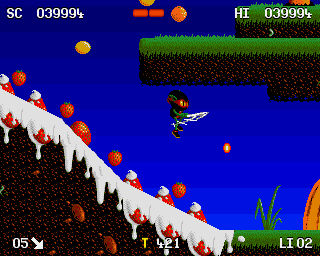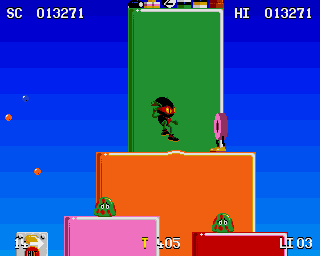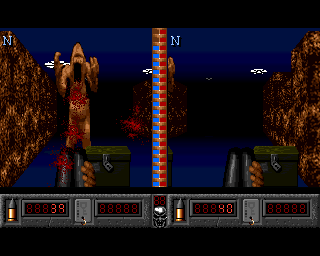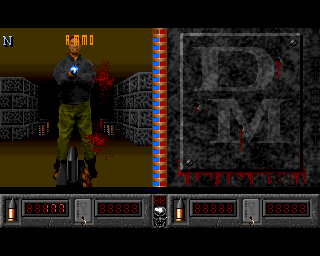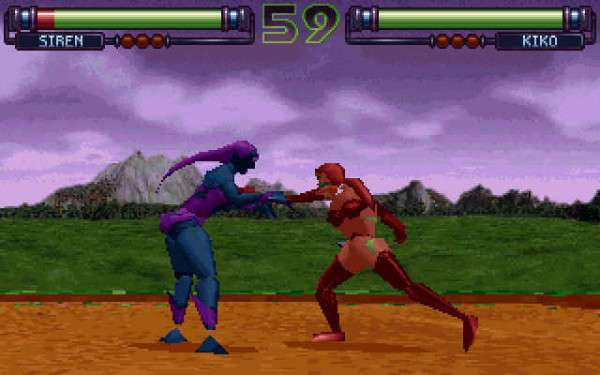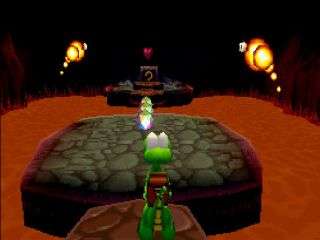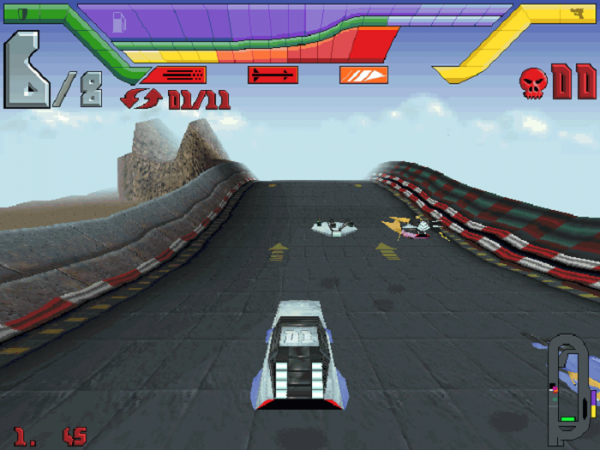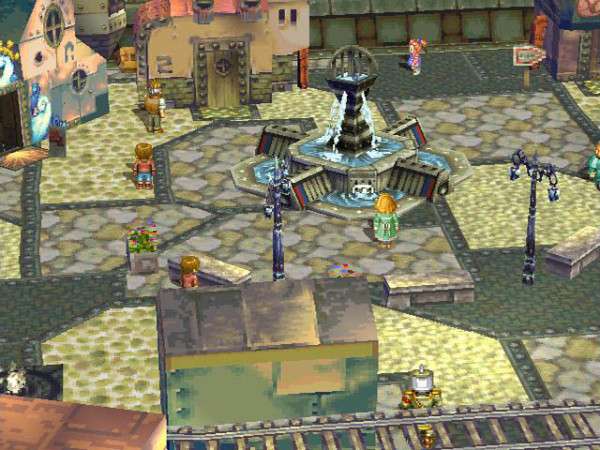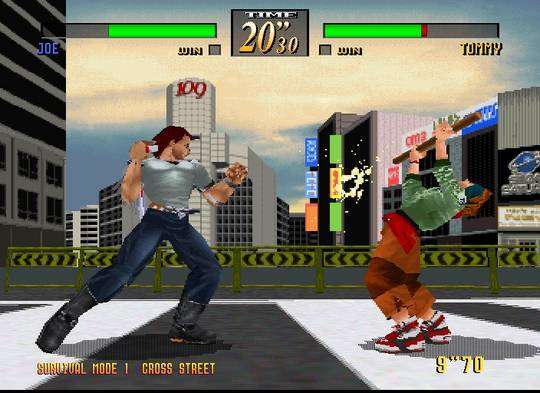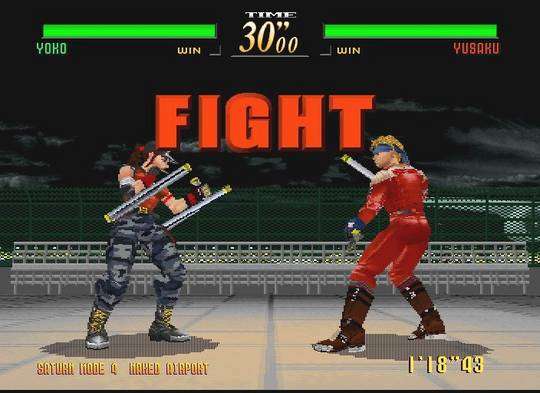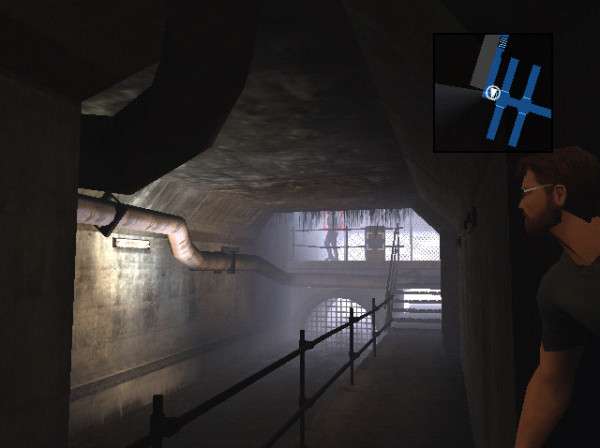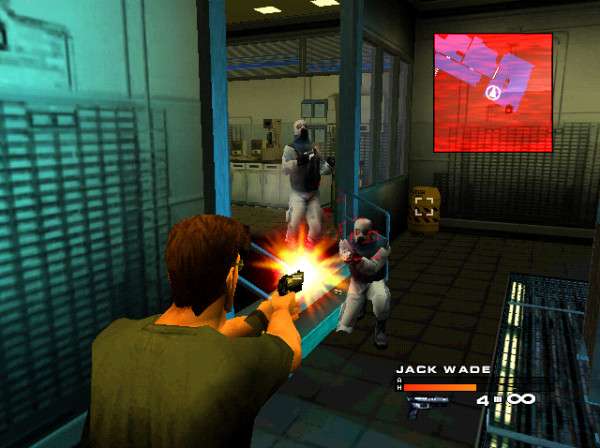
Love the one you’re with: A video game odyssey
My first computer was an Amiga 600. Showing up at school, thrilled to share my news, I was promptly told that an Amiga wasn’t a computer; that it should be a PC to be a computer. That distinction didn’t matter to me, but as a result I couldn’t play Doom. You were supposed to play Doom back then. Super Mario Bros. – check! Doom – not check! Gasps, and so forth. Although PC and console gamers lived on completely different planets, Doom and Super Mario Bros. were both considered required playing. Regardless, I couldn’t play it. I had an Amiga. I had to look elsewhere.
In fact, looking elsewhere defined large portions of my gaming habits. I regularly felt compelled to find substitutes for the games I desperately wanted to play. Come with me, won’t you, on a tour of the games I convinced myself were as good as the ones I wished I was actually playing. It’s a story about love; about not getting the one you want so you love the one you’re with. As far as I recall, it all started with Sonic The Hedgehog. Or Zool: Ninja of the Nth Dimension, rather!
My best friend’s little sister had a Sega Megadrive, which gave neither my friend nor me the all-access to a Megadrive that you’d expect. To the extent that we were allowed a bash on it, however, me and my friend would play almost exclusively Sonic The Hedgehog 2. I was usually relegated to playing Tails in the game’s kinda-co-op mode; a thankless job of having trouble keeping up, getting stuck on things and sorta faux-dying repeatedly–but I still had a good time. And let me tell you; especially compared to a chubby, moustachioed plumber, Sonic was way cool. The music on stages was all DADADADADADADA, DADADADADADADA, BEEP BEEP BEEP BOOP BOOP BOOP (Chemical Plant Zone), and not jazz that it would take almost 10 more years before either of us could appreciate.
We weren’t going to admit to our Sonic swooning, of course. We were proud Nintendo fanboys, brought on by nothing but the fact that we both had Super Nintendos. What better way to deal with not being able to freely play a certain game than to convince yourself that whatever you have is better? In 2015 it’s still the number one method used by fanboys everywhere.
So, I looked for an alternative, and the games I found promising similarly speedy spectacle were Bubsy and Zool: Ninja of the Nth Dimension. Bubsy was a dire experience, more concerned with elaborate animation than responsive character control. Zool, however, played alright. It was developed by Gremlin Graphics specifically for the Amiga back in 1992, and although it wasn’t quite as obvious as, say, Giana Sisters to Super Mario Bros. or Turrican to Metroid, it was clearly derived from Sonic The Hedgehog. It let you hastily jump (check!) and spin (check!) across sometimes food or candy based landscapes (hmm.) and Chupa Chups product placements (what?). Zool himself was just sort of a green man in a ninja outfit, and not particularly charismatic, but I still drew some fanart and stated that the game was cooler than Sonic The Hedgehog a few times, probably.
As we move on through my storied history of self-delusion, it’s all going to blend together a bit in my head, so I’m just going to jump around in a vaguely chronological order. Let’s go!
Doom! I couldn’t play it – wistful sigh. So, I looked for the perfect substitute and found it in a game called Death Mask. And by perfect substitute I mean it was a marginally more dynamic looking Dungeon Master with guns in it. You jerked forward one tile at a time and did 90 degree turns in a grid pattern, trying to find your way through samey looking pseudo-3D representations of corridors. Developed for Amiga by Apache Software and released in 1995, two years after Doom, it didn’t exactly set anyone’s world on fire. It did have a shotgun sprite eerily similar to the one in Doom, though, so that was pretty exciting. It also had split screen co-op, which I gladly forced on my friends, who probably wished they were watching someone play Doom instead.
I didn’t know at the time that the more advanced Amiga 1200 saw a much closer (and more blatantly obvious) approximation of Doom in Black Magic Software’s Gloom, released the same year. The roads not travelled, eh? Anyway; for Christmas that year my parents bought a PC, and I finally played Doom proper in all its IDDQD and IDKFA glory. In the tradition of grass being greener, however, I soon found new games I wished I was playing.
- Death Mask had enemies like this claymation Chewbacca.
- Player 2 could die, and then reappear if P1 completed the level. This made them happy/not happy.
Seeing Virtua Fighter in the arcades did a real number on me. This was a time before 3D accelerators became a thing for PC. Quake hadn’t come out yet, and even though the Super Nintendo dabbled in polygons with the likes of Starwing (Star Fox elsewhere) and Stunt Race FX, witnessing Virtua Fighter for the first time was staggering. My brain could barely process what was happening when the camera panned and zoomed and spun around the fully three dimensional visage of Akira, Pai, Jacky and friends. Arcades were scarce here in Sweden already back then, and this encounter was just a day trip to the city of Gothenburg – about 130 miles from where I lived – making my access to Virtua Fighter agonisingly fleeting.
Upon returning home I obsessively rummaged through my video game magazines, looking to find out when it was releasing for Super Nintendo. I didn’t know how unfeasible that would be due to the giant hardware performance gap. And, uh, it was made by Sega, so it would’ve been pretty awkward. I was a child! I didn’t know who made the games! Anyway, the hunt was on.
The nearest neighbour I could find to Virtua Fighter was a PC game called FX Fighter. It was a polygonal fighting game by Argonaut Software, replete with memorable characters like… the praying mantis man… the muscular action man… the- uh. Maybe there was a robot? I can’t remember. I loved it, though. I mean I tried really hard to love it. It employed a two button setup and some standard quarter circle, half circle, back-forward, forward-back type inputs – a mix of your Mortal Kombatses and your Street Fighterses. Just like Virtua Fighter in that regard, really. The comparisons end there, though, because it was stiff and plodding and you’d just kinda take turns knocking each other over.
Sega eventually released Virtua Fighter on PC, and even though my computer was throwing up from the mere thought of running it, I bought it anyway and sluggishly moon jumped around at single-digit framerates. The trademark Virtua Fighter roundhouse kick went on for like fifteen minutes. Didn’t matter; I was in love. My passion for Virtua Fighter later made me abandon the idea of getting a Nintendo 64 and opting for a Sega Saturn instead. This propelled me away from Nintendo altogether – there was a new Sega fanboy in town.
- FX Fighter. Look for it at EVO.
- “Venam”? Really? 😐
Having to show all sorts of fingers to Nintendo and Sony met with some heavy blows in Mario 64 and Metal Gear Solid. They really tested my resolve, I can tell you that much. With the Sega Saturn famously struggling with polygonal games, Mario 64 beckoned simply with the fundamentals of hopping around in a 3D world – of doing what the Sega Saturn’t. (I… don’t know what that means.)
Enter literally any 3D platformer I could find. Enter, for instance, Croc: Legend of The Gobbos! Starring Croc the crocodile. I’m assuming he’s a crocodile based on his otherwise really misleading name. The game – which incidentally was also developed by the aforementioned Argonaut Games – was a free roaming 3D platformer for Sega Saturn, which was a very rare thing at the time. Not for a lack of 3D platformers, mind. Complete mascot frenzy was still rampant during the mid-to-late 90s, and attempts to emulate the success of Mario 64 were in no short supply. On Playstation you quickly had 3D platformers piling up, but with Saturn flailing both commercially and 3D performance wise, you’d be lucky if one appeared at all.
- Remember when every game had a lava level? Remember when games had levels?
- Croc was looking for crystals and Gobbos, kinda like we’re all looking for something, you know?
That made Sonic’s long-in-development 3D debut, Sonic X-Treme, into a wonderful pipe-dream, and the 3D hub of the 16 bit Sonic collection Sonic Jam teased free roaming Sonic stuff ahead of what was never really going to be any 3D Sonic games on the platform. The exception being the pseudo-racing game Sonic R, which, albeit delightful in many ways, was hardly a substitute for Mario 64.
Unlike me, my best friend had gone with the much more sensible choice in the Sony Playstation. A decision that naturally put a little bit of strain on our relationship, but more specifically it meant a seemingly endless parade of things I couldn’t play, marching past me like cartoon stakes on legs. The entire initial batch of Playstation games were blindingly snazzy, but possibly the most potent among them was Wipeout.
My go-to Wipeout surrogate was called Hi-Octane. This Deep Impact to Wipeout‘s Armageddon was developed by none other than Bullfrog of Syndicate, Magic Carpet, Dungeon Keeper and Peter Molyneux fame. The latter being a person. Hi-Octane was way better than Wipeout because, uh, it had like a truck wipeout in it. There was one ship that looked like the standard wipeout wipeout, maybe with a hint of the ship from Starwing, but then there were also additional wipeouts that looked like totally different things. That made it better. I’m pretty sure that’s what I argued. Also, you sometimes raced over terrain rather than tracks, so you could be hovercrafting your way through a canyon environment, kicking up dirt with your hovery exhaust… thing. However future hovercrafts work. This was marginally different from Wipeout and therefore probably a reason for it being much, much better.
- Hi-Octane. You’d think future hovecrafts would run on electricity or compost or something.
- Look at all those wipeouts!
The Playstation was on a total roll and bagged one of the most talked-about games ever in Final Fantasy VII. I honestly wasn’t even interested in RPGs, and thought the way characters took turns bopping each other on the head was totally lame, but FF7 was such an irrefutable presence in video games that I was basically conditioned into wanting an alternative to it. When the Final Fantasy VII Reunion Tracks album hit, featuring a mindblowing orchestra and choir version of SE-PHI-ROTH, ba-da-da-da-daaaa, I couldn’t take it any more. I looked to the then-upcoming RPG Grandia – developed by Game Arts and touted for the longest time as a Sega Saturn exclusive – to fill the spot.
I waited forever for it to come out here, but it never did. It was eventually ported to Playstation, and that version received an english translation and a western release, but that obviously didn’t help me at all. During that sweet year-or-so of anticipating it as a Saturn exclusive, however, you could clearly tell from the pictures in the magazines that it had amazing, realtime 3D backgrounds and much more comfortable looking clothes than Final Fantasy VII, already besting it in two important areas. Having caught up with the game nearly a decade later, it was a legitimately wonderful game that I still have a lot of genuine fondness for.
- Look at those clothes! So snug.
- You can’t spin your cities around like this, Final Fantasy 7!
The Final Fantasy VII “summon attacks” were a particular source of envy. Visually spectacular and rendered in realtime, they demonstrated the considerable performance advantage of the Playstation. I remember feeling barely-detectable bursts of pride when Shining Force III characters would conjure up, like, an ice lady that did some ice business. We both knew it didn’t compare, though, and looked at one another with quiet empathy.
Namco’s Soul Edge (Soul Blade elsewhere) was also hard to ignore, with all of its weapons twirling and characters gracefully dancing around. There was just something very striking about the movement and animation in it. And yo – weapons in a 3D fighter. Luckily, Sega was on top of the situation and, post-haste, provided the weapons based street fighting game Last Bronx. It was developed by Sega’s AM3 studio, but used a three button layout identical to AM2’s Virtua Fighter series – guard, punch and kick. Even though it could be perceived as a counter to Soul Edge, it played nothing like it, and wouldn’t resign to the dial-a-combo strings that made Tekken and Soul Edge so visually spectacular.
But more importantly! It was a lot better than Soul Edge because… it was way more realistic because it didn’t have all those snazzy visual fireworks! None of that coloured lighting and transparency and light flares and stuff! Annddddd- Uh… Actually it was probably only better because of that. Oh, and it had like a hand drawn anime intro that was one minute long, and that was a lot better than the lush CG rendered intros on Playstation. Ahem. Never mind that Soul Edge prrrrrrrrobably has the best video game intro of all time?
- With a t-shirt, jeans and the name “Joe” you know somebody didn’t try very hard.
- Tonfas! Last Bronx was alright.
I’m slowly realising that this article should have been called Simon the insufferable fanboy. You gotta admire my commitment, though. No? Okay that’s fine. Prolly shouldn’t, really.
Metal Gear Solid is the centerpiece, the culmination of this story arc. It was probably the single most egregious Playstation exclusive, because literally everything about it was the coolest damn thing a 16 year old me could possibly imagine. It had like a gruff sounding dude with a bandana, secretly jacking guys and crawling through ventilation shafts like John McClane. It had the most badass opening moments of any game – possibly any thing – I’d ever seen, with the secret swimming into the base and sneaking to the elevator and removing the mask during the ride up, and the credits coming in just like a movie, and the snow falling, and- aaaaAAAAAAAAAH! But it was my destiny to not like it, so I had to pull myself together! *self slap*
Alas, it also had the fewest alternatives on competing platforms, let alone platforms I owned. The closest thing was probably Operation Winback, but that was on Nintendo 64, and I stuck to Sega consoles like glue to… the thing you stuck glue on. After years of agony, a game arrived on the Sega Dreamcast with the same wall-hugging and stealthy neck-snapping. Amuze’s third person shooter Headhunter starred a cool guy who wore sunglasses, rode around on a motorcycle and distracted guys by throwing coins in a Robocop-esquely satire-peppered sorta-future. There was a lot of shooting, a lot of peeking around corners and a little bit of open world motorcycling breaking up the action. The game saw a Playstation 2 port and sequel – Headhunter: Redemption, also released on Xbox – but came and went without fanfare. Apart from, you know, me tooting my horn about it.
- Not only does he wear sunglasses indoors; he wears them in the sewer! What a dickhead.
- Bang! Bang bang bang! Okay I couldn’t think of a caption.
This story wraps up around pretty much the same time. In February of 2001 Sega announced their withdrawal from the hardware market, and in abandoning the Dreamcast and announcing the next Virtua Fighter for Playstation 2 instead, they effectively dissolved my inclination for stubborn brand loyalty. Their spreading games out across all platforms was an invitation for me to embrace them all. Needless to say, it helped that I was making my own money at that point and could spend it however I wanted, but without that move on Sega’s part, I would likely have remained deeply entrenched in skewed fanboy logic.
I sometimes miss playing the kind of games I’ve listed, because while the successful gaming no-brainers are remembered for you, nobody is going to bring up Death Mask. By the same token, these circumstances and fanboy tunnel vision made me miss out on the glory years of some of the biggest video game franchises of all time, and the connection that the lucky people who played them at the time feel is something I truly envy. But we are who we are, and we play what we play.
Here’s a list of games and my substitutes. I probably forgot heaps.
| Game: | Stand-in: |
|---|---|
| Doom | Death Mask |
| Cool Boarders | Steep Slope Sliders |
| Fighting Force | Die Hard Arcade |
| Final Fantasy VII | Magazine screenshots of Grandia |
| Mario 64 | Croc: Legend of the Gobbos |
| Metal Gear Solid | Headhunter |
| Ridge Racer | Screamer |
| Resident Evil 2 | Deep Fear |
| Soul Blade/Edge | Last Bronx |
| Sonic The Hedgehog 2 | Zool: Ninja of The Nth Dimension |
| The Bouncer | Zombie Revenge |
| Virtua Fighter | FX Fighter |
| Wipeout | Hi-Octane |
| Tekken Tag Tournament | Fighting Vipers 2 |
Did you play games in lieu of other games? I would love to hear about it!
